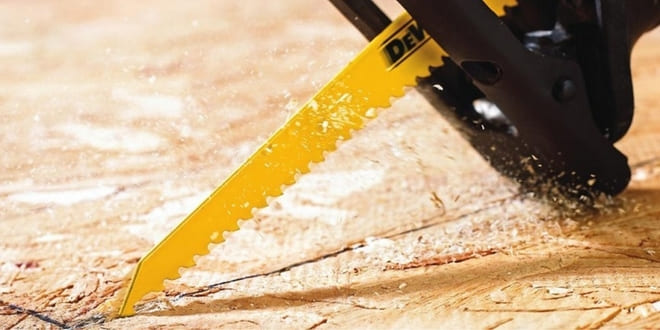
A reciprocating saw is a versatile tool with a blade. Unfortunately, it is an inactive tool without its blade. It means the activity of a reciprocating saw depends on its blade.
A wide range of reciprocating saw blades is available in the market. Based on your project and the material that you are going to cut, you have to choose the right reciprocating saw blade.
By keeping this point in mind, I have created this article to give you an overview of the reciprocating saw blade types. Your work will become much easier once you finish reading this article.
Different Types of Reciprocating Blade
Based on the various factors, the manufacturer makes reciprocating blades. Each blade differs from another based on the design, material, TPI, and others.
Teeth
Every reciprocating saw blade contains sharp teeth that can cut any material easily. For every different task, you need to have a different toothed blade. And taking care of these blades are inevitable because they are heavily sharp to do immense injury.
Depending on the TPI, the teeth group is made. The TPI stands for teeth per inch.
The TPI maintains a range which is 2 – 24. The upper TPI will ensure a smoother cut, and you will get a slower cutting experience.
And the lower TPI will give you a faster cutting experience. However, lower TPI-toothed blades are rougher than higher TPI-toothed blades.
You can choose a lesser TPI blade for cutting wood. On the other hand, an upper TPI blade is suitable for cutting metal-type objects.
Design
You will find 2 types of reciprocating saw blades. The first one is high-carbon steel, and the next one is high-speed steel.
Another reciprocating saw blade is there, which is a combination of these 2 types of blades and is named a bi-metal blade.
High Carbon Steel
You will get a popularly used reciprocating saw blade in the market.
High carbon steel blades are inexpensive, flexible to use, and bendable that don’t break. Because of these reasons, the popularity of this blade is on the increasing trend among users.
To cut softer materials like plastic and softwood, high-carbon steel reciprocating blades are the most suitable ones. They are the most durable among all the other blades.
Avoid using this blade on hard or metal-type objects because they will become blunt if you do so.
High-speed Steel
Compared to the high-carbon steel blade, high-speed blades are less flexible and harder as well.
It means this type of blade will break if you force them to blend. As a result, it is significantly essential to select the right kind of blade for separate materials.
In terms of cutting hard materials, the high-speed steel blade is a suitable one because of its robust characteristics. And they don’t get dull when used to cut metal-type materials.
Bi-metal Blade
As I stated earlier, it is a combination of high-carbon steel and high-speed steel blade.
As a result, the lifecycle of this blade is 10X more than the other 2 types of blades. Due to its longevity, this blade is chosen by many contractors nowadays. However, as an alternative blade, they are a bit pricier.
Risks of Using Wrong Blades in Reciprocating Saw
As every blade is responsible for different tasks, it is advisable to use the right blade for the right purpose.
It is because safety should get a priority.
Although, you can interchange the blades when required.
Many consequences will happen if you use the wrong blade. Initially, your blade will become damaged. The blend may happen to the blade, and often the blade may break down due to wringing speed and the wrong material.
Not only does it damage the blade, and it also damages your compensation, but also it can lead you to an accident that can prove fatal.
Safety Tips
- When you are cutting walls or floors using a reciprocating saw, learn whether any electrical wires, heating vents, and plumbing pipes are present in the way of the working area or not. Be very careful not to cut any electric wire or plumbing pipe at the time of cutting the wall or floor.
- When you are changing the blades or other accessories, remember to unplug the reciprocating saw.
- When cutting metal, make sure of all safety equipment, like an earplug, face mask, hand gloves, and goggles.
- Reciprocating saws are likely to kick back. The tip of the blade will shake into your material if the blade pulls out of a cut. Thus, the saw will jerk violently. All of a sudden, this type of incident can happen, and you may lose control. Be careful about this type of incident, especially when you are working on ladders.
- The reciprocating saw blade creates a high level of heat. Just after finishing a cut, don’t touch the blade.
Frequently Asked Questions (FAQ)
Can I have some specimens of separate blades and accessories that I can work on in a reciprocating saw?
There are uncountable numbers. However, below is a list of particular blade applicationsWood-pieces.Metallic object.Nail-embedded wood.Polyvinylchloride tubing.Boards of plaster.Stone and clayCable brush/sander accessories
Can I use reciprocating saw blades for any project?
Yes, without any confusion, you can use reciprocating saw blades for any project. Thus, you can state this tool as universal. The shank of your reciprocating saw blade will allow any brands and designs.
What essential things do I need to keep in my mind while purchasing a reciprocating saw blade?
Below points need to keep into consideration while purchasing a reciprocal saw blade material Type.Teeth per inch.Blade Material.Tooth material.Tooth patterns.Blade length.Blade thickness.
Final Thought
With a little knowledge about different types of reciprocating saw blades, you will be able to choose the right blade, and your efficiency will undoubtedly increase at your job site.